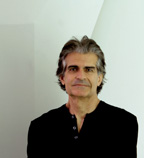Portrait of a City, Darkly
The Works of Photographer Jim McHugh
 By Joseph Giovannini
By Joseph Giovannini
Over the last hundred years, Los Angeles has perhaps been the most filmed, photographed, storied, and advertised city in the world, mediated every which way as subject, object, foreground, background, myth and real estate. The Los Angeles that has filtered into our mind’s eye is an extroverted, sun-splashed place dotted with palms and laced with flowing freeways. We see the city from the wheel of a BMW accelerating onto an on-ramp of perpetual good news. As soon as a film director trains the camera at a stand of lofty Washingtonians, its fronds swaying against a peerlessly blue sky, we instantly know where we are. David Hockney distilled this conventional visual wisdom and transformed the cliché into art with tableaux that built on the splash in the pool, its aquamarine hues, and skies capable of dissolving solid matter into luminosity.
This is not the eye that Jim McHugh brings to his camera. He sees through his lens darkly, and evocatively, capturing a noir Los Angeles saturated with atmosphere and a hazy ambiguity. His eye prefers crepuscular light, and dawn, and it monumentalizes LA by treating buildings, even signs, as icons that create a city of stature. McHugh’s family has lived in Los Angeles for four generations, and his grandfather, the illustrious songwriter Jimmy McHugh, arrived in the city on the 20th Century Express. The grandson sees time, character and even monumentality in a city too often characterized as a capital of ephemera.
Rarely does he photograph a structure whole. The photographic purpose is not documentation, but feeling. We see parts of buildings, leaning and visually unstable, and the images engage our imagination and seem to ask for a script. He photographs signs—Felix Chevrolet, Perino’s, the Cocoanut Grove—capturing words that once were worlds of their own, to evoke times past, again engaging our imagination in storied realms. His surreal eye mystifies Los Angeles through images of structures as prosaic as oil wells silhouetted against a darkened sky, black on black. Even the Beverly Hilton, a specimen of Modernist architecture designed for clarity and simplicity, emerges with the cast of celluloid history, and the patina of an elusive glamour.
To deliver these capsules of time, McHugh resorts to an older technology, he photographs with a vintage 30s Speed Graphic Camera made famous by camera noir legend Weegee. He shoots various types of Polaroid films; prints are often frayed at the edges, faded and discolored, as though they’ve just been exhumed from a box unopened for decades.
McHugh specializes in the city hiding in plain sight—the Wilshire corridor, and parts of Hollywood and Downtown, where Los Angeles is a city rather than suburb. His establishing shots are the Art Deco department stores along Wilshire and LA’s pre-War mid-rise apartment buildings, all crested with a name—the Los Altos, the Lido, the Ravenswood. Collectively this group of images establishes an armature of elegance and urbanity that was once perhaps the rule but now escapes our modern consciousness: it’s not the narrative we live here today. His lens, however, is not sentimental, and he also avoids seeing Los Angeles for the leveling forces of Pop culture. Counter intuitively, his shots verticalize a horizontal town, making it tall and solid rather than flat and insubstantial. But always under a big sky, as though on a screen in a drive-in movie theater. He does not photograph the city in motion, but at rest, as a place to be rather than as a place through which to drive.
His eye chooses to see a more heroic Los Angeles, when the buildings and the signs were the larger-than-life stars of a city that seemed built within an architectural studio system, when Wilshire Boulevard was a mile of miracles. A city that is today still understood as open, spacious and insouciant acquires instead the emotional density of a sky of ominous clouds that lightning will soon crack open. His grandfather may have written “On the Sunny Side of the Street,” but the grandson prefers the shadows of the shady side, and strays into the dramatically charged, emotionally tense aesthetic neighborhoods occupied by Hitchcock, Orson Welles and Raymond Chandler. In his evocative and provocative ensemble of photographs, what emerges is not only a unique portrait of a well-known city, but also a photographic vision of a city that is completely original, McHugh’s own.
Joseph Giovannini writes on art and architecture for The New York Times